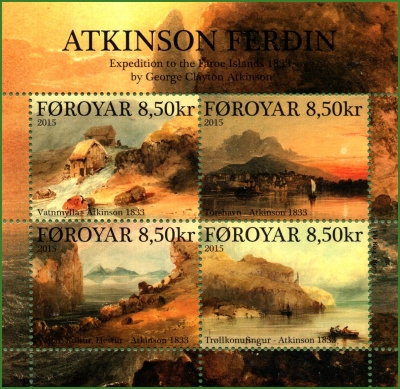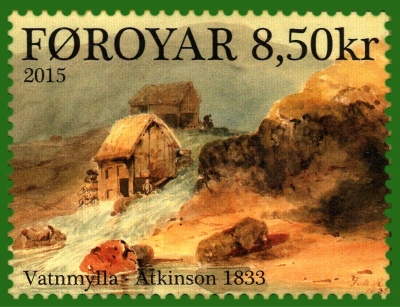-
G.C. Atkinson’s Expedition to the Faroe Islands in 1833
Faroe Islands 2015.02.23
In issue: Souvenir sheet(s): 1
Printing: multicoloral offset
-
Number by catalogue: Michel: BL36 Yvert: F822 Scott: MS717 Gibbons: 638
Perforation type: 13 ¼x13 ½
Subject:
Souvenir sheet with four stamps for 8.5 DKK.
The stamps illustrate paintings by D.K. Atkinson* from his expedition to the Faroe Islands in 1833.
The first stamp of the sheet is the traditional watermill of the islands of that period.Additional:
*English travel writer, artist, and naturalist George Clayton Atkinson (1808-1877) set sail for the Faroe Islands on May 26, 1833. He left Newcastle, aboard the Peggy, to embark on a three-month research expedition. Of particular interest to Atkinson, who was accompanied by William Cookson and William Proctor, were the birdlife, geology, and folklore of the Faroe Islands and Iceland. In the years leading up to this expedition, Atkinson had also explored and written about the natural and human history of the Shetland Islands and the Hebrides.
George Clayton Atkinson’s expeditions throughout the North Atlantic are rarely referenced in Nordic circles. His scholarly work is nevertheless so revered in other parts of Europe that Queen Elizabeth II deemed it fitting to present a copy of Atkinson’s Journal of an Expedition to the Feroe and Westman Islands and Iceland 1833 to Iceland’s President during her first official visit to Reykjavík in June 1990. This remarkable volume also contains some of the first and most interesting descriptions and images of the Faroe Islands that have ever been committed to record.
Relatively few depictions of the Faroe Islands were produced in the late 18th and early 19th centuries. This dearth of drawings, paintings, and narrative accounts of the archipelago, in the years between the Stanley expedition of 1789 and the La Recherche expedition of 1839, make Atkinson’s detailed journal and sketches all the more valuable.
Atkinson’s first encounter with the inhabitants of the Faroe Islands took place near the island of Vágar. It was there that Peggy happened upon a French vessel conducting illicit trade with a group of Faroese. Atkinson noted that the Faroese were afraid of contracting cholera and chose to remain in their boats: “They didn’t have much interest in money, but they brought sheepskins, milk, and other goods to trade. The French exchanged red wine and cognac for the items the natives offered. They certainly were a curious bunch of people.”
When Atkinson later arrived in the archipelago’s capital, Tórshavn, he made the acquaintance of Sheriff Christian Pløyen (1803–1867). Atkinson was well-liked wherever he went on his expedition, and he found that he had much in common with his hosts. The conversations that Atkinson enjoyed are reflected in the insightful quality of his keen, empathetic observations. Furthermore, he considered the Faroese to be an honest, educated, religious, and attractive people.
The images that have been selected to commemorate George Clayton Atkinson’s expedition to the Faroe Islands were originally sketches made by Atkinson himself. These sketches were subsequently rendered into watercolor paintings by the renowned English artist Thomas Miles Richardson (1784-1848). The paintings feature several different motifs: a Faroese watermill, the rock formation Trøllkonufingur, a waterfall in Vágar, the town of Tórshavn, landscapes with vistas over the islands of Koltur and Hestur. Journal of an Expedition to the Feroe and Westman Islands and Iceland 1833 contains twenty-nine full-color works of art in addition to four portraits. At least four artists have contributed artwork to this volume: George Clayton Atkinson, T. M. Richardson, George Richardson, and Henry Perlee Parker.
Size (of sheet, booklet) mm: 94x91
Topics: Mills in Art Watermills




